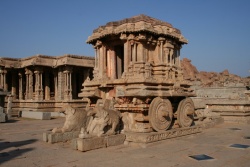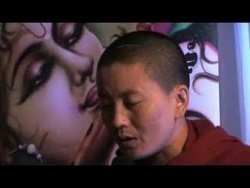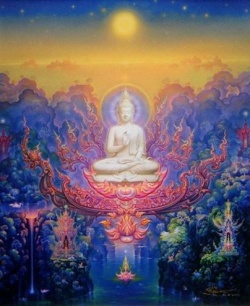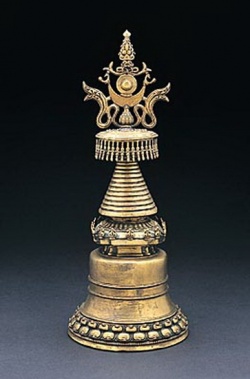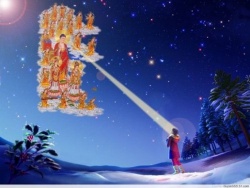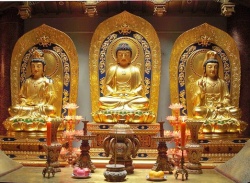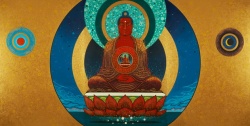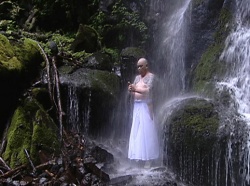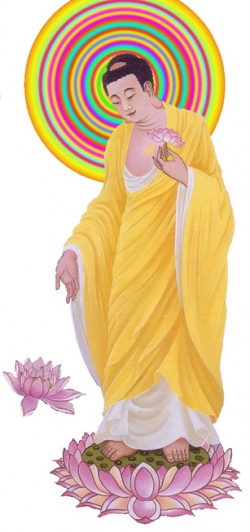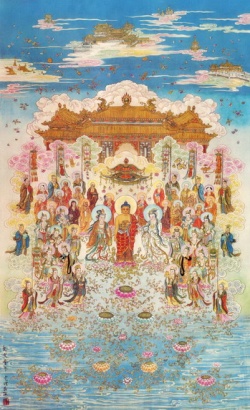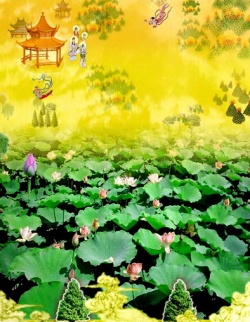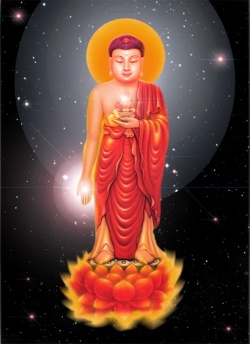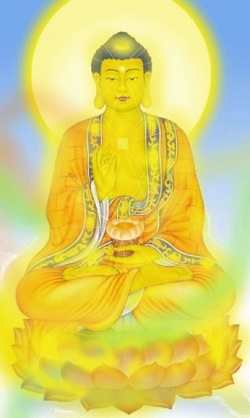Amitabha sadhana
GIVEN BY
VENERABLE TULKU TENGA
INTRODUCTION
HOW AMITABHA ACHIEVED BUDDHAHOOD
A long, long time ago, before this era known as the Superior Aeon, there appeared in the world a Buddha called Jikten Wangchuk Gyalpo. His attendant, a monk named Gelong Chöchi Lodro, showed great mindfulness, intelligence, understanding, and diligence, and he took the Bodhisattva Vow from this Buddha. For thousands of millions of years, he applied himself earnestly to spiritual practice with the intention of helping sentient beings towards full realisation. He also made a sincere wishing-prayer that, on his attainment of enlightenment, he would manifest a buddha-realm incorporating all the qualities of a million buddha-realms within it.
Many thousands of millions of years later, in the aeon known as 'Zinpa', Gelong Chöchi Lodro was born as a chakravartin monarch, Zipji Muchee ('Rim of Spokes'). One of his ministers, the brahmin Gyamtso Dul, had a son, Gyamtso Nyingpo, who became ordained and, feeling wearied with samsaric existence, he attained full realisation in that very life, becoming Buddha Rinchen Nyingpo (Ratnagarbha).
This world ruler, Zipji Muchee, and his retinue made many offerings and served this Buddha with great respect. "Over many of my former lives," said the king, "I've made this aspirational prayer to create a buddha-realm." The Buddha gave him this prophecy: "Many aeons ago you were the gelong Chöchi Lodro. Now you are Zipji Muchee, and in a future life you will become Buddha Amitabha."
For thousands of millions of years Zipji Muchee practised the Dharma. He vowed that he would not achieve buddhahood until every being who prayed to be in his buddha-realm could be born there. Eventually his wishing-prayer was fulfilled, and he became Amitabha. The buddha-realm he manifested is known as Déwachen. Ten aeons/kalpas have passed since Amitabha established that realm.
THE QUALITIES OF DÉWACHEN
In general, to enter a buddha-realm, one must have removed even the most subtle of obscurations, kept very pure samaya, and have attained the first bodhisattva level. So, for ordinary beings, it is very difficult to enter a buddha-realm. However, due to Amitabha's strong wishing-prayers, anyone who makes a sincere wishing-prayer to go to Déwachen can be reborn there, even though one has not purified unvirtuous karma nor liberated oneself from the disturbing emotions.
In this present Superior Aeon, the Bodhisattvas Manjushri, Chenrezig, and Vajrapani, as well as deities, nagas and humans, requested Shakyamuni to teach "The Sutra of the Pure Realm of Déwachen". This sutra describes the qualities of Déwachen. In brief, these qualities are that the earth is made of precious substances, the ground being as flat as the palm of a hand, not uneven like our world of mountains and valleys. It is vast and spacious, and the light shining from the body of Amitabha, and from the jewels and precious substances, makes it very clear. The ground is not rough, solid or stony, but soft, smooth and comfortable. If one were to press down on the ground, it would give way and spring back like foam rubber.
In Déwachen, the trees are made of 7 precious gems: all the roots are of gold, the trunks are silver, the branches lapis-lazuli; the large leaves are crystal and the small ones are pyrites; the blossoms are pearls and the fruits are diamonds. Whatever one wishes for appears from these trees. Jewels, tassels and adornments loop from one tree to another. Birds and animals, unlike those of our world, are manifestations of Buddhas and bodhisattvas. Some are the colours of conches, turquoises and corals, and their bird-calls are very enchanting, like the sound of a lute. Within those sounds are taught the vast and deep teachings of the Dharma.
The rivers flow softly and gently, carrying the fragrance of camphor and white and red sandalwood. This water has 8 qualities: its essence is very cool, its taste delicious, its outer appearance light, soft to the touch, very clear and unsullied by stones or pebbles; if drunk, it gives no harm to the throat or stomach. On the water are buddha-manifestations of geese, ducks and cranes. One can bathe in the many pools, reached by descending flights of 7 steps made of precious stones.
Although these pools are deep, as one enters, the depth of the water adapts itself to the size of one's body. Surrounding these bathing-pools are fragrant utpala and lotus blooms, emanating light-rays. At the tips of the light-rays appear innumerable Buddhas, each surrounded by Arhats.
Within this buddha-realm resides Amitabha, known in Tibetan as 'Öpamé', meaning 'Immeasurable Light' or 'Limitless Radiance' because light-rays from his body pervade every buddha-realm, illuminating them all. He is also known as Buddha Amitayus, or in Tibetan 'Tsépamé', meaning 'Immeasurable Life', because the extent of his life cannot be calculated. His body is as red as ruby, which symbolises the warmth of his compassion extending to all beings.
Amitabha has the 32 principal and 80 secondary marks of a Buddha, like Shakyamuni. On his head, one of the main marks is the head-mound or 'ushnisha', gained whilst he was practising the spiritual path (as Chöchi Lodro and Zipji Muchee), from bowing down with reverence to the Buddhas Jikten Wangchuk Gyalpo and Rinchen Nyingpo. As a result, at the time of attaining buddhahood, the head-mound appeared. Amitabha's 'one face' symbolises that the dharmakaya is free from all conceptual complication. His 2 arms represent means and wisdom, and his 2 hands in meditation gesture signify the unification of means and wisdom. He holds a begging-bowl filled with amrita, symbolising his kindness towards sentient beings by giving vast and deep Dharma teachings. He wears the 3 dharma-robes, denoting gradual instruction of beings through Sravaka, Pratyekabuddha and Bodhisattva Paths. As he never wavers from resting in the equality of samsara and nirvana, his legs are in vajra-posture.
Amitabha sits on a throne that is supported by 8 peacocks. When the sutras and commentaries describe the 5 buddha-families, a particular aspect of wisdom and a specific direction are ascribed to each one, even though they each embrace every aspect of wisdom. Amitabha is associated with the western direction, and he embodies discriminating wisdom, which arises when thoughts of desire and craving are purified. Within the minds of ordinary beings, all the kleshas are present: anger, desire, ignorance, pride, jealousy and so on. It is believed that birds, in particular, have strong desire and craving, so, as a symbol of craving transformed into discriminating wisdom, Amitabha's throne is supported by peacocks.
In other practices, Akshobya is associated with the eastern direction and his throne is supported by horses; Ratnasambhava with the south, his throne supported by elephants; Amoghasiddhi with the north, his throne supported by shang-shang creatures; Vairochana with the centre, his throne supported by lions.
On Amitabha's throne is a 1000-petalled lotus, which symbolises that he remains unstained by samsara. Although he has attained liberation, he has not abandoned his body nor entered nirvana, but stays in the world, due to his compassion, in order to benefit beings. His back rests against a bodhi tree, 600,000 yojanas high, and its branches, leaves and flowers extend 800 yojanas (1 yojana is approximately 4 miles). Due to our impure vision, we only see a small bodhi tree at Bodhgaya, but once we are reborn in Déwachen, a bodhi tree resembles this one described above. It is called a bodhi tree because every Buddha has one, and when one achieves buddhahood, it is obligatory that one must have a bodhi tree to lean against! (Rinpoché chuckles). The cause for achieving buddhahood is to take the Bodhisattva Vow and to develop bodhicitta. In every sadhana practised, one takes refuge and generates bodhicitta. The bodhi tree symbolises bodhicitta.
To Amitabha's right is Chenrezig, with 4 arms, and to his left Vajrapani, with 2 arms. The fact that both are standing symbolises, first, that until samsara has been emptied they will work to liberate sentient beings, and, secondly, that they are disciples of Buddha Amitabha. They are surrounded by an infinite number of Buddhas, Bodhisattvas, and Arhats all with head-mounds, and wheel-marks on their hands and feet, wearing dharma-robes.
In Karma Chagmé's long 'Déwachen Prayer', he describes Amitabha, Chenrezig and Vajrapani as 'very vivid' by using 3 synonyms. Firstly, they are physically 'vivid' (Tib. lhang ngé) because, amongst the entourage of Buddhas and bodhisattvas, they stand out as exceptional, like 3 supreme mountains. This is due to the proportions and qualities of their major and minor marks of buddhahood. In terms of speech, they are also 'vivid' (Tib. lhan né) because first Amitabha teaches Dharma, followed by Chenrezig and Vajrapani, and at that time their speech permeates all the buddha-realms. For the mind aspect, Amitabha is again described as 'vivid' (Tib. lham mé), because of his compassion.
Having taken birth in Déwachen, one does not hear any more even the mere names of the 8 unfavourable states, or of the lower existences . In Déwachen, there are no ordinary women with anger, pride or desire. In this world, sometimes men love women, and at other times they are angry with them and quarrel, yet feel great suffering when they die. However, in Déwachen there are only goddesses, 3000 emanated to serve each individual.
If someone in Déwachen wishes to visit the other pure realms of, for example, Vairochana, Ratnasambhava, Tara or the Glorious Copper-Coloured Mountain of Guru Rinpoche, one can simply go there, receive empowerments and teachings from those particular Buddhas, and return again to Déwachen. Having been born in Déwachen, one possesses unobscured clairvoyant powers, including the ability to see other beings in their particular worlds and give them protection and blessings, or, at the time of their death, to go to the bardo to meet them and bring them to Déwachen. All these qualities of Déwachen are explained in "The Sutra of Amitabha", which was eventually brought to Tibet and translated by the learned lotsawas, and now exists as part of the Kangyur.
THE SADHANA
This Amitabha sadhana is a terma teaching called "The Space Dharma" (Tib. nam chös), revealed by a tertön, Minjur Dorjé. It is a 'realisation-terma' that arose within his mind, with visions of Amitabha, from whom he received these teachings. Rigdzin Minjur Dorjé was an emanation of the translator Vairocana (8th C.), and of Shubu Palji Sengé. Karma Chagmé brought the tertön to his residence at Nédo, and when these visions and instructions from Amitabha came to Minjur Dorjé, Karma Chagmé wrote them all down. There are 13 volumes of these teachings.
When he was 19, Minjur Dorjé went to Katok, a famous Nyingma monastery, where he gave the Space Dharma teachings to Palyul Kunzang Sherab (Penor Rinpoché) and 25 tulkus. Karma Chagmé compiled these mind-treasures and visions, writing them down Karma Chagmé's first teacher was the 5th Trungpa Rinpoche, Kunga Namgyal. His root lama was the 6th Shamarpa,Chöchi Wangchuk. There is a vast life-story of Karma Chagmé's practices, studies and visions.[He lived from 1613-1678 and was 17 years old when his teacher the 6th Shamarpa passed away. From 1649-1662 he did a 13-year retreat, during the last 7 years of which he was accompanied by the young Nédo Minjur Dorjé (1645-1667), whose visions he compiled as the Space Dharma teachings. While sadhanas from this form the 'Nédo Kagyu' tradition, the entirety of his teachings has been transmitted as the central basis of the Palyul Nyingma tradition.] In later life, Karma Chagmé went to Nampatsé, passed away and is said to have gone to Déwachen.
THE ACTUAL PRACTICE
LINEAGE PRAYER
The first verse of 4 shlokas (page 1b in the Samye-Ling translation ‘Amitabha Prayers’, 1987 edition) is a supplication to Amitabha, followed by a verse to Chenrezig, Vajrapani and their vast entourage of bodhisattvas and arhats. Next (page 2a), there is a verse of supplication to 'The Second Buddha', Padmasambhava, and his 25 main disciples in Tibet, and to the 84 mahasiddhas of India. As this practice first appeared as a mind-terma of Minjur Dorjé, the next 4 shlokas are to him and to all the gurus who received the empowerments and instructions from him. These verses supplicate the gurus. There follow 4 shlokas to the yidam deities, both those who are peaceful manifestations such as Manjushri, Tara, and Chenrezig, and those with wrathful aspects, such as Dorjé Phurba and Channa Dorjé (Vajrapani). After this, one supplicates the Dharma protectors (2b), Palden Lhamo and Mahakala, and the guardians of this practice, the Shingchong protectors. In the final verse one prays that, through the blessing of having supplicated in this way, all one's illness and suffering will be pacified; one's life and merit will be increased; one will be reborn in Déwachen and become inseparable from Amitabha. Throughout this prayer, one is praying with faith and devotion. There is no special visualisation.
In order to be born in Déwachen, one needs 4 causes:
1) whatever virtue one is practising, one must do it with bodhicitta motivation; 2) the realm of Déwachen, with its special features, must be imagined clearly;. 3) one must purify one's bad karma, and accumulate good karma; 4) one must pray many times to be reborn in Déwachen.
These 4 Causes will be explained below.
1) REFUGE & BODHICITTA
When reciting the first 2 lines (3a), one takes refuge in the 3 Jewels and 3 Roots. Imagine Amitabha in space before one, encircled by gurus, buddhas, bodhisattvas, yidams, protectors and dakinis. One imagines oneself and all beings taking refuge in Amitabha.
The following 2 lines are the development of the bodhicitta attitude, whereby one thinks: "I'm going to practise this Amitabha sadhana, in order to establish all beings in buddhahood." Having recited the refuge and bodhicitta verses 3 times, Amitabha and his whole entourage dissolve into light and merge into oneself.
BLESSING THE OFFERINGS
(3a) One imagines that from emptiness the 7 offerings appear, as well as the amrita, torma, and rakta. They are inexhaustible offerings filling the whole of space.
Of the 4 causes for rebirth in Déwachen, the first, the prerequisite of bodhicitta motivation, has been covered in the refuge and bodhicitta part of the sadhana. The next part is the basis for rebirth in Déwachen: the visualisation of developing the realm.
2) THE VISUALISATION
There are 2 parts to this: imagining oneself as the deity, and imagining the deities in front. Other tantric practices have an elaborate procedure for developing the self-visualisation, followed by the front-visualisation. This sadhana has just a simple procedure.
(3b) Imagine Déwachen with its soft, springy ground. In the centre of a pond of water, with the 8 special qualities, is an 8-petalled white lotus, its petals almost closed. In its centre is oneself as Chenrezig, white in colour, with head-mound and 2 arms, hands together at the heart in prayer-gesture, one's lower body hidden within the lotus.
In front of one is a precious throne, supported by 8 peacocks. On it is a thousand-petalled lotus and a moon-disc, on which Amitabha sits, as red as a ruby, with 2 arms, his 2 legs in vajra-posture. A begging-bowl filled with amrita rests on his hands, which are in meditation gesture. His back rests against a bodhi tree. To his right is Chenrezig, white in colour, standing on a moon-disc and lotus, with 4 arms: 2 hands in prayer-gesture at the heart, and the other two holding a lotus and mala.
On Amitabha's left stands Vajrapani, on a lotus and moon-disc. He is blue in colour, with 2 arms, holding a vajra and bell in his right and left hands respectively.
INVITATION
(4a) In the 3 places of the Amitabha, Chenrezig and Vajrapani in front of one are a white OM, red AH, and blue HUNG, and in one's own heart, a white HRIH. Light-rays of 5 hues go out to Déwachen, inviting the 3 principal deities, and they arrive in space before one. The damtsigpa deity of one's own visualisation is already in front, and one now imagines that the yeshépas, the wisdom-beings, become inseparable from one's visualisation.
(Tenga Rinpoche was asked to explain the terms 'yeshépa' and 'damtsigpa'. This was his explanation:
The commitment-being, 'damtsigpa' (Tibetan) or 'samayasattva' (Sanskrit) is the deity one is imagining, i.e. oneself as the deity or the deity in front. From both oneself and the deity in front light-rays go out inviting the deity from the buddha-realm: the wisdom-being, 'yeshépa' (Tib.) or 'jnanasattva' (Skt.).
In the word damtsigpa/samayasattva, 'damtsig'/'samaya' is a changeless commitment. When one imagines oneself as Chenrezig, one does not change back into an ordinary being, or into another deity. It is a changeless commitment. The '-pa' (short for 'sempa') or '-sattva' is a hero, or someone with courage. This means that sometimes during meditation the deity can become unclear, but one has great courage and the strength to prevent that from happening, to remain clear. Thus all the faults in the development and completion stages of visualisation are unable to defeat one. That is why it is termed '-sempa' or 'brave one', 'hero'. Through meditating on the damtsigpa, clinging to the 5 skandhas is purified, and the result of this purification is the attainment of the sambhogakaya state in the bardo.
As regards the yeshépa/jnanasattva whom one invites, 'yeshé/jnana' is the pure nature of one's own mind and the nature of a Buddha's mind too, they are identical. The Buddha's awareness of the mind being dharmakaya, or primordial mind, is called ultimate wisdom, or 'yeshé.' The '-sempa' refers to the fact that in the dharmakaya one is free from all thoughts of something existing or not. One is free from all these faults or complications. At this time, one is inviting the primordial wisdom, 'yeshé', in the form of the deity, who merges into oneself as the damtsigpa. Through meditating on that, the ignorance of one's own mind is purified. What makes this purification possible is the innate purity of the dharmakaya mind of a Buddha and the purity of the essence of one's own mind. The result of this purification is the attainment of the dharmakaya at the time of death, when the 'ground luminosity' appears, along with the 'clear light of the path'.
In the nyingma tradition, one visualises oneself as the damtsigpa, and in one's heart is the yeshépa, the size of one's thumb. In the heart of that small deity is the 'ting-dzin-sempa' (skt. 'samadhisattva'). So it is slightly different.]
From oneself as Chenrezig emanate innumerable bodhisattvas exactly the same as oneself. They offer thousands of prostrations and circumambulations to Amitabha in front of one, in this way confessing and purifying the powerful bad karma and obscurations of beings. The mantra of invitation is "OM AMI DEWA HRIH. BENDZA SAMAYA-DZA. DZA HUNG BAM HO. TITRA LHEN. ATI-PU HO."
If it was a wrathful practice, " DZA HUNG BAM HO " would represent the activity of the hook, noose, chain, and bell, but in the peaceful practice:
"DZA" signifies "summoning" - all the lights coming from the 3 places invoke the wisdom-deities to come into space before one;
"HUNG" means "remaining" or "residing" - the wisdom-deities, whom one has invited, and one's own visualisation, the commitment-deities, are essentially the same: the essence of the mind of a buddha and of one's own mind is emptiness and appearance inseparable;
"BAM" signifies "binding" - the wisdom-deities and one's own commitment-deities become mixed with each other, like water into water;
"HO" means "pleased" - after the wisdom-deities and commitment-deities have blended, they feel great joy and happiness at being able to accomplish the benefit of beings.
"TITRA LHEN" is a request to definitely remain; "ATI-PU HO" is a mantra of homage.
EMPOWERMENT
(5a) From the HRIH in one's heart, lights radiate to the 10 directions inviting the 5 buddhas of empowerment and their consorts. The 5 Buddhas scatter flowers and recite prayers of good fortune. The 5 consorts hold vases of good fortune full of amrita with which they give empowerment to Amitabha, Chenrezig, and Vajrapani in front. Amitabha's body fills with wisdom-amrita, and the excess overflows from the top of his head to transform into Amitayus, who remains as his head-adornment. The 5 Buddhas and consorts dissolve into Amitayus.
This head-adornment of the master of the relevant buddha-family is customary for all tantric practices. All deities from the Vajra family have Akshobya as their head-adornment; those from the Ratna family have Ratnasambhava; all from the Lotus family have Amitabha; from the Karma family, Amoghasiddhi; from the Buddha family, Vairochana. For the buddhas themselves, as there is no-one higher than them to become master of their family, they take different aspects of themselves as their head-adornments. Amitayus, as the sambhogakaya form, is above Amitabha, who is the nirmanakaya form. They are essentially the same Buddha.
3) GATHERING THE ACCUMULATIONS & PURIFYING KARMA
The third factor one needs to practise in order to be reborn in Déwachen is gathering the accumulations and purifying one's bad karma and obscurations.
(5b) Countless bodhisattvas emanate from oneself as Chenrezig, holding vases of amrita for washing the 3 principal deities. Although they have no dirt, smell or stain on their bodies, one enacts this as a good sign (Tib. 'tendrel') for the purification of bad karma and obscurations.
This is followed by the drying of their bodies with soft, white, scented cloths, as a good sign for removing suffering in one's own and others' minds.
The bodhisattvas hold the 3 dharma-robes for the nirmanakaya deity, Amitabha, and dress him.
There are basically 3 dharma-robes:
- the outer robe has 25 vertical sections, each divided further into 5 parts;
- the upper robe has 9 vertical sections, each divided into 3 parts;
- the lower robe has 8 vertical divisions, each divided into 5 parts.
There are elaborate, medium and simple forms of these robes, and within these categories there are elaborate-elaborate, medium-elaborate, simple-elaborate and so on, making 9 possibilities in total. Although Amitabha does not feel cold, one offers these 3 types of robes as a token of increasing the vitality of oneself and others.
One offers to Chenrezig and Vajrapani crowns, bracelets, lower robes, and jewellery. These bodhisattvas, who are in sambhogakaya form, have 13 types of adornments, comprising 8 types of jewellery and 5 types of silk clothing.
The 8 jewelled adornments are:
- a jewel crown or tiara called "The 5 Buddha-Families";
- jewel earrings;
- a short necklace;
- a necklace reaching to the heart;
- a long necklace reaching to the navel;
- bracelets and armlets (1 of each for each arm);
- anklets;
- a belt or 'girdle' at the waist, with loops of jewellery hanging from it.
The 5 silks are:
- a 'back silk', i.e. a silk ribbon hanging from the back of the head, just behind the tiara, like a tassle;
- 'silken earlobes' - the tiara stops just behind the ears with a decorative pattern of 5-coloured silks which hold the back silk tight, and these silks hang down behind the ears;
- some deities have a short blouse, and others have a floating scarf;
- a red silk skirt, or some have a skirt 'like Indra's bow', which means a rainbow-coloured skirt;
- on top of this red lower skirt is a blue silk.
One also finds variations of these 13 types of adornments in the instruction texts. One offers these, not because Chenrezig and Vajrapani have a desire to possess such jewels and clothing, but in order to create the karmic conditions for increasing the majesty and splendour of oneself and all beings.
After the bodhisattvas have offered the drinking-water of the 8 qualities, as an auspicious sign for oneself and all beings becoming free from suffering, they merge back into oneself as Chenrezig.
Now, from one's heart, emanate many beautiful dakinis of individual colours, each holding a specific substance to offer. First, yellow dakinis appear with scented water of the 8 qualities to wash or cool the feet of Amitabha, Chenrezig and Vajrapani. Jamgon Kongtrul explains in a Guru Yoga practice the reason for this offering: it is not because their feet are dirty or hot, but in order to purify the incidental stains in one's own mind, so that in future one will be endowed with immaculate wisdom. The offering made, these yellow dakinis merge into the feet of the Buddha and 2 Bodhisattvas. It will be the same procedure for all the subsequent offering-dakinis: after completing the offering they merge into the corresponding part of the recipients' bodies.
White dakinis offer flowers. Amitabha will be neither pleased nor displeased if these are offered or not, but, through making this offering, one can remove the suffering in one's own mind, and in future one will be able to please beings by possessing the body of a buddha with the 32 major and 80 minor marks. These dakinis merge into the eyes of Amitabha, Chenrezig and Vajrapani.
Blue dakinis offer incense. This offering is made to purify the stains of one's conduct. If one has broken commitments, one will have to experience the results of this negative karma and the obscurations that it produces. In the future, through making this incense offering, one will have stainless, correct conduct. The dakinis merge into Amitabha's nose.
Red dakinis offer butter lamps, in order to clear away ignorance and stupidity in one's mind, so that, in future, one will attain the clear light of ultimate wisdom (skt. jnana). The dakinis merge into Amitabha's hands.
Green dakinis, carrying scented water, anoint the bodies of Amitabha, Chenrezig and Vajrapani. This offering is made to eliminate duality in one's mind: clinging both to perceptions and to their perceiver (the mind itself that grasps). In the future, one will attain the non-conceptual state of the samadhi of shamatta and vipassana. The dakinis merge into the bodies of the 3 deities.
Yellow dakinis offer food to the tongues of Amitabha and the 2 Bodhisattvas. This offering eliminates the sufferings of hunger and thirst experienced by sentient beings. It also eradicates greed, the cause of these miseries. In the future, all beings will be able to enjoy the food of samadhi. The dakinis merge into the deities' tongues.
Yellow dakinis offer music, in order to eliminate all the sufferings of sound experienced in the 3 lower existences, so that, in future when one is teaching Dharma, one will have a voice as melodious as that of Brahma. The music-offering dakinis merge into Amitabha's ears.
One then emanates many beautiful dakinis, who make the offering of a beautiful consort to Buddha Amitayus on top of Amitabha's head. This is offered in order to eliminate the sufferings of the hell-realms that result from anger, greed and craving, so that, in the future, one will attain a state of bliss and emptiness.
Following this, from the tips of one's fingers (as Chenrezig), which are in prayer gesture, rays of light bearing the 8 auspicious substances, the 8 auspicious symbols, the 7 possessions of a chakravartin, and the mandala of Mount Meru and the 4 continents are offered to Amitabha, Chenrezig, Vajrapani and the entourage.
Why are the 8 substances considered auspicious? They were all offered to, and subsequently blessed by, Sakyamuni Buddha. Since that time, if one gives or receives any of these as a present, one thinks, "This is a good sign, a very auspicious substance!" There is auspiciousness and inauspiciousness related to everything. In the practice of Dharma, every circumstance is considered to occur according to the 'laws of interdependence', and sometimes events can happen auspiciously or inauspiciously. For example, if one wishes to go into retreat, and one has a retreat house, food provided, a lama to give one instructions, good caretakers, freedom from illness and so forth, these are favourable conditions and are considered auspicious, or of good fortune. Conversely, if one needs to find one's food, falls ill, things always go wrong, or there seem to be obstacles and one cannot complete what one wishes to do, that is called inauspicious.
Each of these 8 substances was offered to, and blessed by, the Buddha:
- white mustard-seed was offered by Vajrapani;
- a straw-seller offered durva grass as a seat for the Buddha;
- a tree-goddess offered bilva fruit (applewood);
- Longchen Sasong offered 'givang' (ambergris) which comes from an elephant;
- the goddess of earth offered red lead (minium);
- a dairymaid, Lekchéma, offered yoghurt that had been condensed from the milk of 2000 cows;
- the goddess of form, Zukchi Lhamo, offered a mirror;
- the Lord of Gods, Indra, offered a white conch.
One offers these substances, not because Amitabha considers them auspicious or inauspicious, but in order that all beings will have the auspicious good fortune of being able to accomplish the practice of Dharma.
Following this, the 8 auspicious symbols are offered: when practising on the path, a bodhisattva bows with reverence and respect to his teachers, and as a result, the head-mound appears, one of the physical signs of a Buddha. The parasol is of a similar shape to a Buddha's head-mound, so one offers this auspicious symbol and prays that one will have the good fortune of this physical sign of buddhahood, as a consequence of offering this symbol. A golden fish is offered to the eyes of Amitabha, Chenrezig, Vajrapani and their entourage. Buddha Amitabha's eyes are long, like the petals of an utpala flower or a golden fish. These eyes appeared at the time that he attained buddhahood, after developing limitless compassion and love for beings while practising on the path.
The Buddha's neck has the shape of a vase, since on the path he nursed the sick and gave delicious food to many. Due to that, on achieving buddhahood, his neck took the shape of a vase, so one offers an excellent vase to the necks of Amitabha and his entourage.
The Buddha's tongue is like a lotus petal, slender, supple and endowed with miraculous powers. While practising the path, he never told any lies. As a result, at buddhahood his tongue took the shape of a lotus petal, so one offers an excellent lotus to the tongues of Amitabha and his entourage.
On the Buddha's throat are 3 lines like the spirals on a conch. He gained this sign by giving medicine to sick people while he practised on the path, and when he achieved buddhahood, these 3 lines appeared. This is why one offers a white conch (with clockwise spirals) to the throats of Amitabha and his entourage.
The knot of eternity is offered, symbolising 2 qualities of the Buddha's mind: he knows the nature of things just as they are, and also the many things that are to be known. He attained these qualities by continually practising the 10 virtuous actions whilst on the path, so this knot is offered to the minds of Amitabha and his entourage.
The body of Buddha is like the victory banner, or like the nyagrodha tree, in that it is neither too small nor too tall but in perfect proportion and size. This body is said to be like a victory banner because he remains always in a state of meditation. One offers this banner to the bodies of the 3 deities and their entourage.
On each of the Buddha's palms and soles is the image of a wheel. While practising on the path, whenever a teacher came to give Dharma instruction, he would go to meet them out of respect and escort them to his residence. Likewise, when they departed, he would escort them some of the way, out of respect. Consequently, at buddhahood, these wheels appeared. They are offered to the hands and feet of Amitabha and his entourage.
As Amitabha has already perfected the 8 qualities associated with these signs, he does not need these auspicious symbols offered to him, but one makes the wish that, due to the virtue gained through making these offerings, in future oneself and others will be blessed with bodies possessing all these signs.
This is followed by offering the 7 precious possessions of a universal monarch, a chakravartin. In worldly terms, after buddhas, bodhisattvas and arhats, the next in degree of merit is a universal monarch. Through the power of his accumulation of merit, such a king attains naturally these 7 precious possessions:
- a 1000-spoked golden wheel. If such a king intends to travel from one continent, such as Lupakpo, to Dzambuling, this golden wheel will land on the ground before he arrives;
- a jewel. It is made of lapis-lazuli, is 8-faceted, and is worn on the king's top-knot. Light-rays from this jewel shine as bright as the sun for a distance of 5 miles even during the night. If one has such a jewel on the top-knot, all one's wishes or prayers will be fulfilled;
- a queen, as wife to the king. She is beautiful to behold, her behaviour is gracious and so forth: she has all the 32 excellent qualities of a woman.
- a minister, white and beautiful. He is very wealthy, yet has the courage to give all his wealth away to Buddhas and Bodhisattvas as offerings, and to other beings as generosity. He is able to endure the hardships in giving away his wealth, so he also has great forbearance;
- an elephant, as white as a snow-mountain in sunshine. When the king rides it, it has the power to fly through the sky;
- the supreme horse: it is the colour of a peacock's neck, has a large tail and thick mane. It is so swift it can go around all the continents in one hour;
- a general. He is very powerful, and through the power of his prayers or wishes all his enemies are pacified, so he never needs to fight wars.
One offers these 7 precious possessions in order to become a chakravartin king in the future.
There follows the offering of the Supreme Mountain and the continents. In the Kalachakra Tantra, the central mountain is described as round, whereas in the Abhidharma system it is described as square. Ultimately, they have no true reality. According to the scientific view, one sees this world and the central mountain as round with all the continents encircling it. Others see the world as flat, like a plate. The Buddha said that in the minds of different beings arise different appearances, on account of their individual karma, but ultimately none of this has any reality. One might think that there is only one world like this, but the buddhas have taught that there are millions of similar worlds, each with a supreme mountain and 4 continents, containing many forms of life.
Before the creation of this world, there was just empty space, but beings were living in other worlds at that time. This empty space appeared as a world due to the karma of beings. First, a lot of air moved in this space for a long time, eventually becoming very solid, like a foundation or ground. The name for this is 'a double-vajra (or vajra-cross) of air'.
Through beings' karma, above this ground appeared a cloud in space called 'the essence of gold'. A heavy rain fell from this cloud for a long time. As a result, on this vajra-cross of air an ocean appeared, called 'the peaceful, solid and permanent ocean' which was soft to the touch, cool and delicious. The air agitated the many particles of gold that were contained in this ocean, and they were brought together, to create the golden basis for the earth. When one makes the mandala-offering, one says: "The completely pure basis, the ground of gold". That part of the offering refers to this layer of gold.
Through the karma of beings there appeared another cloud, called 'various jewels', and it rained for a long time, forming an ocean on this basis of gold. This is the water that people sail on, when travelling in a boat. As this ocean was agitated by the waves for a long time, all the particles of various jewels gathered together like foam on its surface, and gradually formed solid land, in the form of the central mountain, Mount Meru. In the Abhidharma system this mountain is described as square with 4 steps at the bottom, and its 4 sides are crystal (east), aquamarine (south), ruby (west) and gold (north). All the sediment of jewels left in the turbulent ocean came together and formed 7 mountain ranges, encircling the central mountain, made of 7 different precious substances. Between each range (and between the central mountain and the ranges) is an 'ocean of joy', a total of 7 oceans.
On top of Mount Meru appeared the city of Indra and the deities in the 'Heaven of 33'. Within this paradise is contained all the wealth and splendour of deities. In the 7 oceans that lie between the 7 mountain ranges, live the naga kings, and all their wealth is contained there. There are 12 continents around Mount Meru: the 4 main ones of Lupakpo, Dzambuling, Balangchö and Draminyen, each with 2 satellite continents. Apart from Ngayap, the land of the rakshasas, the other 11 are populated by humans, and all of their wealth and splendour are contained therein. When offering the mandala, all the wealth and splendour of the deities, humans and nagas from these paradises, continents and oceans is offered. Although Amitabha does not need these riches, they are offered to perfect one's dualistic accumulation of merit and the non-dualistic accumulation of wisdom. When one has perfectly completed these accumulations, one accomplishes one's own benefit, by attaining the state of dharmakaya, and the benefit of others, by manifesting the form-kayas.
When offering vessels of deathless amrita, one prays for the attainment of the supreme accomplishment (siddhi), i.e. the realisation of mahamudrad the ordinary accomplishments. Altogether there are 8 ordinary accomplishments, such as the 'eye medicine' with which one can see great distances, or see through the ground; 'fast legs', whereby one has the power of great speed; clairvoyance; miraculous hearing; miraculous sight, and so on.
One offers a torma possessing the 100 flavours and the 5 pleasures of the senses, and also rakta, which is essentially an offering of red amrita. It seems, from the longer offering text, that rakta is an offering of blood, but there is not an actual offering of blood poured out. It also appears from the words in the text that the torma is actually made of flesh and blood, but it is only described this way in terms of what one is going to purify. In the longer offering text it says: "crunch the bones of anger and eat the flesh of ignorance, drink the blood of desire." In this way, one imagines these 3 mind-poisons are offered into the deities' mouths and eaten by them, thereby defeating the 3 kleshas.
If one 'offers the anger', in this instance as amrita, the wisdom deity is not actually drinking some amrita. What happens is that thoughts of anger become defeated. Everyone has the 5 mind-poisons. The wisdom-deities have the 5 facets of ultimate wisdom, and by offering one's own mind-poison of anger it becomes transformed into 'mirror-like wisdom'. This is the meaning of the deity overcoming the mind-poison of anger.
Similarly, the ignorance of all beings is symbolised by the torma, and if that torma is offered to the deities, this ignorance can be pacified, diminished, and transformed into 'dharmadhatu wisdom'. The offering of rakta symbolises attachment and craving, which becomes pacified, and transformed into 'all-discriminating wisdom'. When pride, subsumed under the klesha of anger, is pacified, it is transmuted into the 'wisdom of equality'. When envy, included in the desire klesha, is pacified, it is transformed into 'all-accomplishing wisdom'. In summary, if one is offering amrita, torma and rakta to the deities, one should not just practise it merely on the basis of the words of the text, but one needs to understand the underlying meaning.
PRAISES
(11b) The dakinis render homage and sing praises to Amitabha, first to his Vajra Body, which is compared to Indra's body. In Indra's palace of 'Complete Victory,' in the 'Heaven of 33', the roof, ceilings, walls, and floors are all made of precious, reflecting jewels. Although Indra has only one body, his reflected image can be seen in every direction. Sometimes he's known as 'Indra of 100 bodies', as his body is like space, pervading everywhere by means of the reflections. That is the reason this example of 'a body like space' is given in the sadhana, as Amitabha is able to permeate all phenomena with his blessing.
Anyone who has faith and trust in Amitabha is seen by him at all times, and if one speaks to him, he hears what is said. If one imagines that he is present in front of one, he is actually there, due to his compassion. With strong devotion, one will receive his blessing quickly. In spite of animals and fish having no faith in Amitabha, he still regards them all with his compassion, but they receive his blessing only gradually. Due to the nature of interdependence, if faith is present, blessing is received quickly, but if there is little or no faith, blessing is received gradually.
In the Mahayana Uttara Tantra Shastra (translated as 'The Changeless Nature'), it is explained that even though there is only one moon in the sky, it is reflected many times in pools and oceans, in clear or dirty water. Just like that example, Amitabha's activity permeates everywhere. The dharmakaya appears everywhere, dependent on the clarity of one's mind. If the water is agitated, the moon will still reflect in it, but unclearly. It is the same with one's mind: if the mind is agitated, the dharmakaya is not clearly revealed. That concludes the praise and homage to the dharmakaya.
Amitabha's speech is called Vajra Speech as it is unceasing. In terms of the quality of his speech, it is unequalled even by the sound of thunder, and also it is very beautiful, like melodious song or music. When the Buddha teaches, to those nearby his speech does not sound loud, but pleasant and clear, yet those listening far away can also hear it clearly. If one is listening to Amitabha's speech, it never sounds unpleasant, and it possesses 60 special qualities unmatched by melodious song. Rinpoché thinks that this is why the 2 examples, of his voice being unmatched by thunder and melodious song, are given in the sadhana. Out of compassion for all beings, Amitabha continually gives Dharma teachings. That is the praise and homage to the sambhogakaya.
There follows a praise to Amitabha's Vajra Mind, which is endowed with the 2 qualities of knowing the nature of things just as they are, and the many things that are to be known. It is a mind that cares for the welfare of all beings continually with great compassion and impartiality. Even though Brahma is a lord of a thousand million worlds, and Indra is powerful and has great merit, their minds cannot equal the mind of a buddha. One pays homage to Amitabha's mind, residing in a nirmanakaya form. In the text, it describes Amitabha as nirmanakaya, sambhogakaya or dharmakaya. These 3 are simply different aspects of forms. Each kaya has 3 different facets. For example,
the dharmakaya of dharmakaya is Buddha Samantabhadra;
the sambhogakaya of dharmakaya is Vajradhara;
the nirmanakayas of dharmakaya are the 5 lords of the buddha-families.
So, Amitabha, as head of the Lotus family, is classified here as nirmanakaya.
The dharmakaya of sambhogakaya is Vajradhara;
the sambhogakaya of sambhogakaya is Vairochana Gangchentso;
the nirmanakaya of sambhogakaya is Sakyamuni Buddha.
The dharmakaya of nirmanakaya is Amitabha;
the sambhogakaya of nirmanakaya is Chenrezig;
the nirmanakaya of nirmanakaya is Guru Rinpoche.
So, here, Amitabha is the dharmakaya.
CONFESSION AND PURIFICATION
One imagines the offering goddesses prostrating, and confessing any of the 10 unvirtuous actions that one has carried out physically, verbally or mentally. They merge back into the heart of oneself as Chenrezig. When confessing one's breakages of samaya, one needs to generate the 4 remedial powers:
1) feeling regret at former negative actions,
realising they were harmful and should not have been done;
2) resolving not to commit such actions in the future;
3) the power of reliance or support: in this case,
imagining Amitabha, Chenrezig, and Vajrapani in space before one,
and, with them as a basis, one makes the confession;
4) the power of remedy: here it means reciting the mantra OM AMI DEWA HRIH.
If all these 4 powers are complete, then even though the extent of one's negative actions might be comparable to the size of Mount Meru, they will be purified.
PRAYER
There follows a prayer addressing Amitabha and his entourage. It says that with body, speech and mind one is devotedly praying for the supreme and ordinary accomplishments, and through receiving the blessing may one attain the level of Amitabha.
VISUALISATIONS FOR THE MANTRA RECITATION
Having concluded the visualisations for gathering the accumulations, the second part of the development stage involves reciting the mantra and visualising the deity. There are many different ways of developing the visualisation of Amitabha and his entourage: the deity can be complete in an instant of thought, or complete in 3 or 5 stages. From amongst these, here one adopts the visualisation that is complete in an instant. Generally, there are 3 aspects to the development stage:
- clear appearance of the deity;
- stable or strong pride;
- mindfulness of purity.
With regard to the clear appearance of the deity, one imagines Amitabha in front, and one focuses one-pointedly on him: first, his head mound, then his eyes, nose, mouth, ears and so on. Focus successively on all the bodily parts of the deity within the visualisation. If one is looking at the eyes or mouth, then one cannot, at the same time, imagine the head-mound, but that does not matter, as long as one is visualising one part. Imagine the upper part of his body, the lower part, his hands, the begging bowl. Direct the mind to his legs in vajra-posture, and his 3 Dharma-robes, the moon-disc, the lotus, the throne supported by peacocks, the bodhi tree.
'Stable pride' or 'confidence' is to think: "This is truly Amitabha present in space before me."
With regard to 'mindfulness of purity', the form taken by an ordinary being in this life is a result of karma accumulated in a former life. A deity's form, however, appears due to the qualities of buddhahood, from ultimate wisdom. One thinks that the appearances of the deities are not due to former karma.
(13b) Imagine that one transforms oneself from being 2-arm Chenrezig to his 4-arm aspect. In one's heart is the whole of Déwachen, with Amitabha, the 2 Bodhisattvas, and millions of bodhisattvas and arhats. One imagines all this complete in one's heart. Within the heart of this Amitabha is a moon-disc, on which is a red HRIH, encircled by his mantra, OM AMI DEWA HRIH. The mantra faces outwards and turns clockwise, emitting 5-coloured lights that go upwards and come out from his urna hair, between the eyebrows, and then out through one's own urna hair into space, to all the buddha-realms.
From the tips of these light-rays countless offerings appear, and are presented to the buddhas and bodhisattvas in the 10 directions. One thinks that all their power, compassion, and wisdom return in the form of light-rays that enter through one's urna hair, and through the urna hair of Amitabha in one's heart, back into his mantra. Think that one has received all the blessings of the buddhas.
Again these light-rays go out, this time to all the 6 realms of beings, purifying all their bad karma and obscurations, which are the causes for their suffering. In this way, every being gains the good fortune to be born in Déwachen, in the future. Imagine that the whole outer world is transformed into Déwachen, and sentient beings become either Amitabha, or another of the dhyani buddhas, or one of their consorts, or a bodhisattva. From their mouths come the sounds of the mantra, which shake all the lower realms to their very depths, thus completely eliminating them. One thinks that all beings who have form, and also those who are formless (spirits and non-humans) attain the state of Amitabha.
The mantra recited is "OM AMI DEWA HRIH". "AMI" means "limitless light" and "DEWA" means "deity". So the mantra means "deity of limitless light".
In pujas, the visualisation normally practised is this one. It says in the abhidharma teachings, concerning group practice, that if people recite a mantra together with a mutual intention, as they are doing here every evening in Samye-Ling, then even though one person may recite only 1000 mantras, through everyone together completing 100 million mantras, each person who participates will gain the benefit of reciting the whole number of mantras.
(15a) This visualisation is practised after reciting Amitabha's 6-syllable mantra. First, from the HRIH in Amitabha's heart (within oneself as Chenrezig with 4 arms), a chain of red HRIH syllables emerges and exits from his mouth, going upwards to come out of one's own mouth. It enters the mouth of Amitabha in front, and descends to his heart, where it merges into the mantra circle, invoking his compassionate activity to accomplish the benefit of beings. From the mantra comes a chain of red HRIH syllables, which descends to go out through his navel, enters the navel of oneself as Chenrezig, and enters Amitabha's navel at one's heart. One thinks one has gained all the blessings and siddhis from Amitabha. This is called the visualisation 'like a circle of fire'.
Secondly, in the space between one's mouth and Amitabha's mouth in the front visualisation, light-rays of 5 different colours radiate out from the chain of red HRIH syllables to go to the Amitabha residing in Déwachen. They merge into him, and please him as an offering to his body, speech and mind. From his body emanate countless large and small bodies of Amitabha; from his speech, countless mantras and HRIH syllables; from his mind emanate large and small 5-pronged red vajras. They all come like a swirling snowstorm, and merge into oneself as Chenrezig, into Amitabha in one's heart, and into the Amitabha visualised in front. For this visualisation, recite "HRIH" for the time one has available.
(16a) In the vase in front, imagine the whole of Déwachen, with Amitabha, Chenrezig, Vajrapani and their entourage. In the heart of the front-visualisation Amitabha and in the heart of the Amitabha in the vase is a moon-disc, on which stands a red HRIH encircled by the long 'dharani-mantra' of Amitabha, turning clockwise. Light-rays go out from this dharani, purifying all the bad karma and obscurations of every sentient being. From Amitabha's body in the vase, amrita flows and fills the vase completely. For this visualisation, recite the long dharani, which was taught by the Buddha in the sutras.
(16b) After the mantra recitation, one recites the 'Alphabet Prayer' and the 'Epitome of Interdependence' 3 times, followed by the 'Offering and Confession Prayer'.
THE CONCLUDING PRACTICE
PRAYER OF GOOD WISHES
(17b) One recites a short prayer beginning: "OM DRUP-PAR JYURCHIK...", wishing to accomplish the vajra-body, speech, and mind of Amitabha. This is followed by a prayer of confession and the 100-syllable mantra. One confesses one's impure samadhi, incorrect recitation and any omissions.
DISSOLVING THE VISUALISATION
(19a) The whole front-visualisation of Amitabha and Déwachen dissolves into light, which subsequently merges into oneself as Chenrezig. One transforms into Amitabha. In the heart of oneself, as Amitabha, in an open lotus blossom is the whole of Déwachen, with Amitabha, Chenrezig and Vajrapani. Meditate that one is the union of clarity and emptiness.
4) PRAYER FOR REBIRTH IN DÉWACHEN
(19b) The 4th cause that prepares one for rebirth in Déwachen is the recitation of the Déwachen prayer. There are 3 versions: a long prayer, written by Karma Chagmé; a medium version called the "Shéja-ma" by the 5th Karmapa, Deshin Shekpa, and this short one from the "Nam Chö" by Minjur Dorjé:
"E MA HO" - this expresses wonder and amazement at the realm of Déwachen and its inhabitants. Amitabha has wonderful, amazing qualities, and through the power of his prayers this realm has appeared. It has qualities superior to those of other buddha-realms. For example, even though there are buddha-realms in each of the 10 directions and also buddha-realms for every deity, in order to be born in any of these realms all one's bad karma and kleshas must have been purified. Once this has been done, then with the appropriate aspiration one can be reborn in the buddha-realm of one's wishes. In Déwachen, however, even if one's bad karma and obscurations have not been purified, but one wishes and prays to be born there, then one's wishes will be fulfilled. Déwachen has this quality because when Amitabha practised on the spiritual path he made the commitment that he would not achieve buddhahood unless it was possible that every being who wished to be born in his buddha-realm could be born there merely due to their wishes and prayers.
Amitabha himself has wonderful qualities, such as, physically, the 32 major and 80 minor signs of a buddha. Light-rays radiate from his body to all buddha-realms. This is why he has the name "Öpamé", meaning "Immeasurable Light". The special quality of his speech is that he continually 'turns the wheel of Dharma' for all beings. His mind has 32 distinctive qualities, i.e. the 10 powers, 4 kinds of fearlessness and 18 distinctive qualities.
On Amitabha's right is Chenrezig, the embodiment of the compassion of all buddhas. He acts to benefit all sentient beings until samsara is totally emptied. The manifestation of his body is the 1000-arm Chenrezig; the emanation of his speech is the 6-syllable mantra; the emanation of his mind is the 6-arm Mahakala; the emanations of his qualities are the yellow and white Dzambala; the emanations of his activity are the white and green Taras. Through these aspects, which make him superior to other bodhisattvas, he accomplishes the benefit of beings.
On Amitabha's left is Vajrapani, who is the embodiment of the strength and power of all the buddhas. If one prays to him, he has the power to eliminate all one's 'maras' and hindrances. At the time of Sakyamuni, Vajrapani requested the tantric teachings, so he is the master of the tantras. His qualities and activity make him also superior to other bodhisattvas.
Around Amitabha, Chenrezig and Vajrapani is an entourage of buddhas and bodhisattvas: those who have accomplished the levels of realisation (skt. bhumis) and have eliminated what needs to be eliminated, as well as those who are still practising on the spiritual path.
The Déwachen prayer continues with "...as soon as I and others have departed from this life, may we be born directly in Déwachen, with none of the delay caused by another birth". To enter other buddha-realms, one needs to have complete purification. For those on the sravaka path, it may take thousands of kalpas of practice, and for pratyekabuddhas, hundreds of kalpas. If one practises the 4 classes of tantras, the path is much swifter, with correct application of the development and completion stages. The anuttara tantra is the most profound, and buddhahood can be attained in one lifetime.
By praying to Amitabha for rebirth in Déwachen as soon as one dies, Amitabha will come to meet one in the bardo and one will go straight to the realm of Déwachen, with no obstacle such as taking another birth. As soon as one is reborn there, one will see Amitabha and receive teachings from him.
"DÉGÉ DAGI MÖNLAM TAPADI..." - whatsoever good action is accomplished, one needs to make a wishing-prayer for rebirth in Déwachen, and to gather the 2 accumulations of virtue and insight. Through virtuous actions of body, speech and mind one gathers merit (dualistic merit) and through practising shamatta and vipassana, one gathers insight (non-dualistic wisdom). By means of these accumulations one will gain rebirth in Déwachen. With one's body and speech one can practise prostrations and circumambulations, giving generously to others and so forth, accomplishing whatever benefit one can for other beings. These are all ways of gathering good actions.
These instructions on the Amitabha practice of Terton Minjur Dorje's "Space Dharma Heart Treasure" were given by Ven. Tenga Tulku to the community of Samye-Ling, with Peter Roberts translating, Easter 1986. The instructions are edited for general use. A more elaborate version, with instructions for Shrine Layout, Vase Visualisation, Long Life Practice, Guardian Practice, Ganachakra and Powa, is available on request.
SARVA MANGALAM

